How to Do Math in Google Sheets
In this article, you will learn how to create simple formulas and run basic math calculations such as addition, subtraction, multiplication, and division in Google Sheets.
Why do you do basic mathematical calculations in Google Sheets?
Here are some reasons why you should consider doing basic mathematical calculations in Google Sheets.
- Accuracy: Using spreadsheet software like Google Sheets can help ensure accurate calculations. Spreadsheets are designed to perform calculations with precision, eliminating the possibility of human errors that may occur when doing calculations manually. This can help prevent calculation mistakes that could occur when using a calculator or doing mental arithmetic.
- Efficiency: Google Sheets allows users to easily perform calculations on a large scale. Users can input data into cells and use formulas to perform calculations across multiple cells or even entire columns or rows. This can save time and effort compared to manual computations, especially when dealing with complex or large datasets.
- Flexibility: Google Sheets provides a flexible and dynamic platform for calculations. Formulas can be easily adjusted or updated, and data can be edited or added to the sheet, allowing for real-time updates and calculation changes as needed. This flexibility makes handling changing data or performing "what-if" scenarios convenient.
- Organization: Google Sheets provides a structured and organized way to store and manage data, making it easy to input, manipulate, and analyze data in a tabular format. This makes it ideal for tasks that involve multiple calculations or data analysis, as data can be organized into rows and columns, and formulas can be applied to specific cells or ranges.
- Collaboration: Google Sheets allows for easy user collaboration, as multiple people can work on the same sheet simultaneously. This makes it convenient for teams or groups to collaborate on calculations, share data, and review or verify calculations in real-time.
Overall, using Google Sheets or other spreadsheet software for basic calculations can provide advantages such as accuracy, efficiency, flexibility, organization, and collaboration, making it a popular tool for various tasks involving numerical calculations and data analysis.
How do you do basic calculations in Google Sheets?
You can calculate math by combining signs and numbers in a cell or signs and cells where numbers are filled in. Look at the following four signs below, which are called operators. These are used to form a basic mathematical calculation in Google Sheets.
Addition: “+” (a plus sign)
Subtraction: “-” (a minus sign)
Multiplication: “*” (an asterisk)
Division: “/” (a forward slash)
In addition to these marks, you can use Google Sheets functions, such as the ADD, MINUS, MULTIPLY, and DIVIDE formulas, instead.
Also, in Google Sheets, there are more advanced formulas that allow you to calculate values easily or under specific conditions.
How to do addition in Google Sheets
Assume you want to run the calculation of one plus one.
- Select a cell you want to show the calculation result.
- Type “=”, “1”, “+”, and “1” (manual input), or instead, select a cell containing 1, type “+”, and select another cell containing 1 (cell reference).
- You can see the computed result of “2” in the cell.
Alternatively, you can insert the ADD formula when you add up two numbers. You can enter the SUM function to aggregate more than two values. The picture below shows some patterns to conduct addition for two or more values.
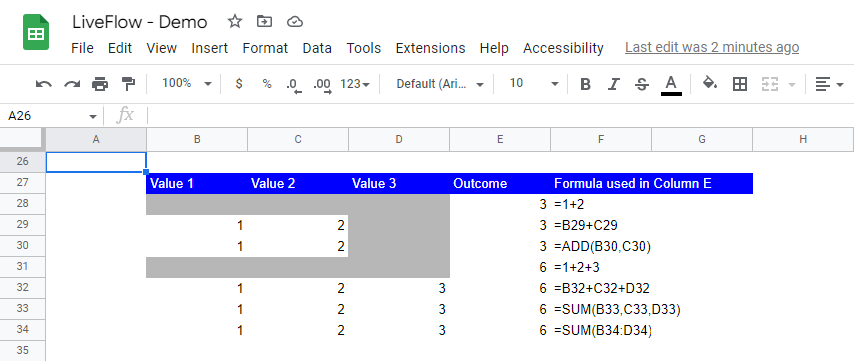
Reference the following articles to learn more about the ADD and SUM formulas.
How to Use Sum Function in Google Sheets
ADD Function in Google Sheets: Explained
How to do subtraction in Google Sheets
Assume you want to run the calculation of deducting one from two.
- Select a cell you want to show the calculation result.
- Type “=”, “2”, “-”, and “1” (manual input), or instead, select a cell containing 2, type “-”, and select another cell containing 1 (cell reference).
- You can see the computed result of “1” in the cell.
Alternatively, you can insert the MINUS formula when deducting a number from another. If you need to do subtraction for more than two values, you should use the minus sign repeatedly.
The picture below shows some patterns to conduct subtraction for two or more values.
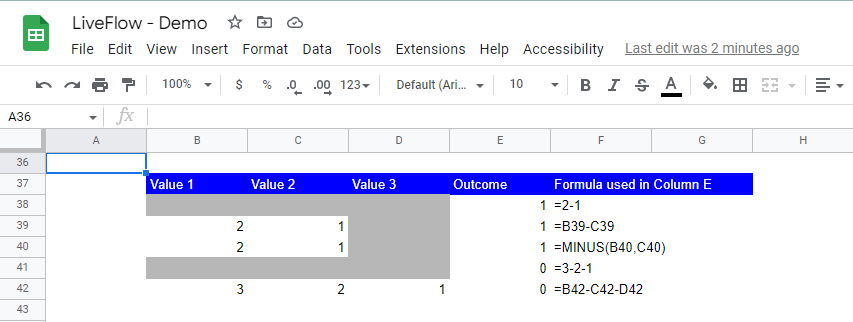
Refer to the following article to learn more about the MINUS formula.
MINUS Function in Google Sheets: Explained
How to do multiplication in Google Sheets
Assume you want to run the computation of multiplying one and two.
- Select a cell you want to show the calculation result.
- Type “=”, “1”, “*”, and “1” (manual input), or instead, select a cell containing 1, type “*”, and select another cell containing 2 (cell reference).
- You can see the computed result of “2” in the cell.
Alternatively, you can insert the MULTIPLY formula when multiplying two numbers. If you need to do multiplication for more than two values, you should use the asterisks repeatedly or the PRODUCT function. The picture below shows some patterns to conduct multiplications for two or more values.
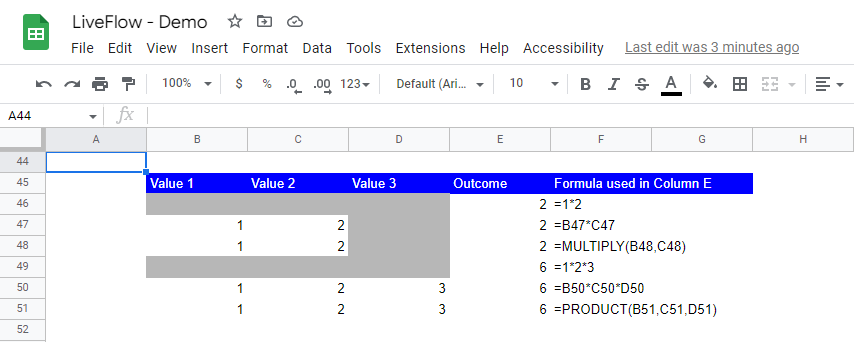
Read the following posts to learn more about the MULTIPLY and PRODUCT formulas.
MULTIPLY Function in Google Sheets: Explained
PRODUCT Function in Google Sheets: Explained
How to do division in Google Sheets
Assume you divide two by one.
- Select a cell you want to show the calculation result.
- Type “=”, “2”, “/”, and “1” (manual input), or instead, select a cell containing 2, type “/”, and select another cell containing 1 (cell reference).
- You can see the computed result of “2” in the cell.
Alternatively, you can use the DIVIDE formula when dividing two numbers. If you need to divide more than two values, use the forward slashed repeatedly. The picture below shows some division patterns for two or more values.
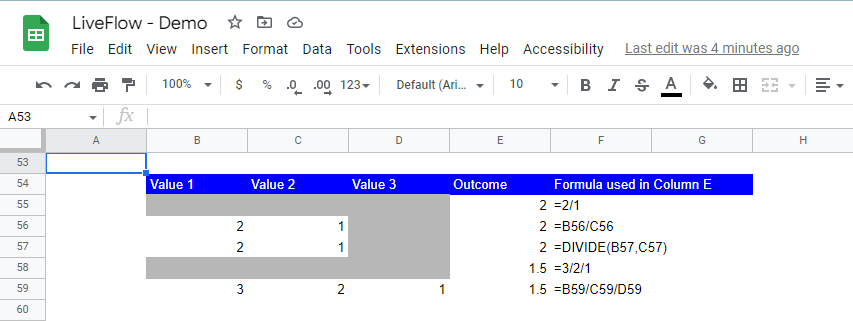
Move to the following page to learn more about the DIVIDE function in Google Sheets.
DIVIDE Function in Google Sheets: Explained
How to use parentheses in Google Sheets
Next, learn how to use parentheses “()”. They are helpful when you need to prioritize a part of a calculation because, in Google Sheets, multiplication and division are prioritized more than addition and subtraction, as in the real world.
Assume a series of calculations of “=1+2*3-4/2.” Without any parentheses, the formula returns 5. If you want to calculate “1+2” first, then multiply 3, and deduct 2 (=4/2), you need to write the formula like this: “=(1+2)*3-4/2.”, which returns 7.
If you want to compute “1+2*3-4” first and then divide the result by 2, you can input a formula of ”=(1+2*3-4)/2”, which returns 1.5. You can see what they look like in the middle of the screenshot below.
Lastly, you can replace specific numbers in a formula with cells filled with numbers.
This is easy to do. You need to combine cells (instead of specific numbers) with signs as you do for the cases of numbers and signs. See some examples below in the screenshot as well.
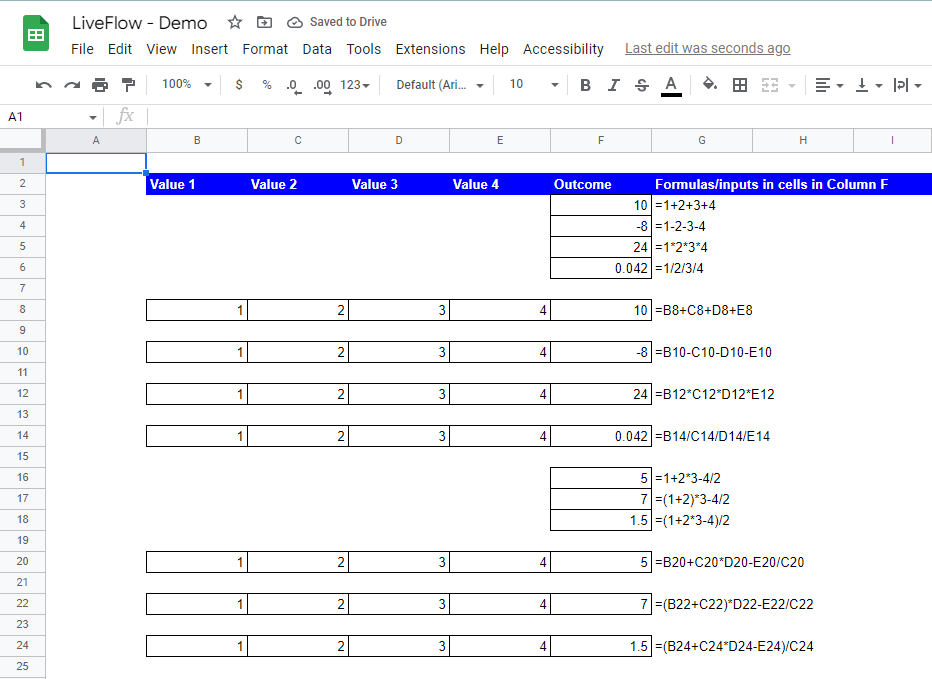
Can you use formulas in Google Sheets?
Yes, you can use a lot of formulas in Google Sheets. Go to the “Insert” tab, and move to the “Function.” You can see an organized list of functions (formulas) you can use in Google Sheets.
Once you select one of the functions and enter it in a cell, you can see more guidance on the procedure (e.g., what kind of inputs are required in the formula and what the order of the information should be). Check out some useful mathematical or statistical formulas in the next section.

